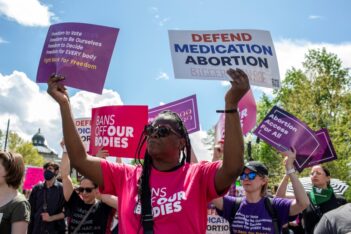
Scholar calls for FDA to remove stringent restrictions on medication abortion.
Abortion-rights activists across the country rallied together in June 2022 to protest the U.S. Supreme Court’s decision that month to eliminate constitutional protection for abortion services. Little did many of the protesters know that a federal regulatory policy adopted decades earlier had already curtailed access to early abortion across all fifty states.
In 2000, the U.S. Food and Drug Administration (FDA) conditioned access to a key abortion drug on unusual distribution restrictions. In a recent article, Greer Donley of the University of Pittsburgh School of Law deplores the detrimental impacts of these restrictions and argues for their removal.
The drug mifepristone thins the uterine lining and hinders growth of the gestational sac, which in turn terminates a pregnancy. FDA’s 2000 decision approving mifepristone also imposed significant restrictions on its distribution: a physician must register with the drug’s manufacturer, get certified to perform surgical abortions, and distribute the drug in person and supervise its administration.
These stringent restrictions mirrored those assigned to certain controlled substances and provoked immediate criticism from scholars, activists, and lawyers. Donley argues that they impede abortion access and should be removed.
The physician certification requirement segregates abortion care from traditional health care settings, claims Donley. Relegating medication abortion to limited prescribers and alternative sites of care only exacerbates abortion stigma, according to Donley. It also creates logistical hurdles for patients who must cover the costs of traveling to clinics, missing work, and potentially paying for childcare.
In addition, requiring that mifepristone be dispensed in person at designated clinical settings curbs telemedicine for abortion care. Even during the COVID-19 pandemic, when the Trump Administration temporarily suspended similar restrictions on other medications restrictions, such as opioids, the mifepristone restrictions remained intact.
According to Donley, the vast majority of abortion patients are low income, which means that FDA’s failure to adapt its medication abortion policy during the public health crisis harmed marginalized communities disproportionately.
Donley contends that the mifepristone restrictions are part of a larger pattern of biased decision-making at FDA. In the past, when challengers have highlighted FDA’s devaluation of women’s health, the agency eventually overturned its decision.
For instance, the Government Accountability Office investigated FDA’s decision in 2005 to reject Plan B’s transition to over-the-counter medication despite unanimous expert support for its approval. After multiple rounds of litigation, Plan B was eventually permitted for over-the-counter sale, but Donley argues that FDA never fully regained credibility after the controversy.
Stakeholders and commentators again accused FDA of bias for refusing in 2010 to approve the female hypoactive sexual desire drug, flibanserin. After five years and three applications for approval, the drug’s sponsor finally convinced FDA’s advisory committee to approve it. Although clinical data supported its safety and efficacy, the committee recommended restrictions that required certified providers to prescribe the drug.
Despite what Donley views as FDA’s troubling track record when it comes to women’s health, recent administrative action suggests that removing the mifepristone restrictions may be feasible in the near future. The Biden Administration dismantled one part of these restrictions in December 2021 when it removed the in-person dispensing requirement and allowed certified pharmacies to prescribe mifepristone.
Still, Donley argues that the retention of a certification requirement for pharmacies preserves a key obstacle to provider participation.
In 2017, the American Civil Liberties Union filed a lawsuit challenging the mifepristone restrictions. Although the case is currently on hold, this litigation could chart a path forward for invalidating the restrictions on administrative law grounds, claims Donley. She contends that FDA acted arbitrarily and capriciously in violation of the Administrative Procedure Act. If advocates eventually win at the lower court, FDA may avoid an appeal to the Supreme Court and remove the restrictions themselves.
Still, even if FDA’s restrictions are removed, states can pass laws that prevent telemedicine for abortion, warns Donley. If the mifepristone restrictions are removed, Southern and Midwestern states that already restrict abortion access may put similar limitations on mifepristone. Despite this potential to “accelerate the existing polarization of abortion access across state lines,” Donley maintains that the benefits of removing the mifepristone restrictions far outweigh its harms.
Although the Supreme Court’s overturning of Roe v. Wade marked a sobering defeat for abortion rights activists, Donley offers another pathway to expand access to abortion care. Removing the mifepristone restrictions would not only break down unnecessary barriers to medication abortion, but could have far-reaching effects on surgical abortion access, reproductive care, and abortion stigma, concludes Donley.



